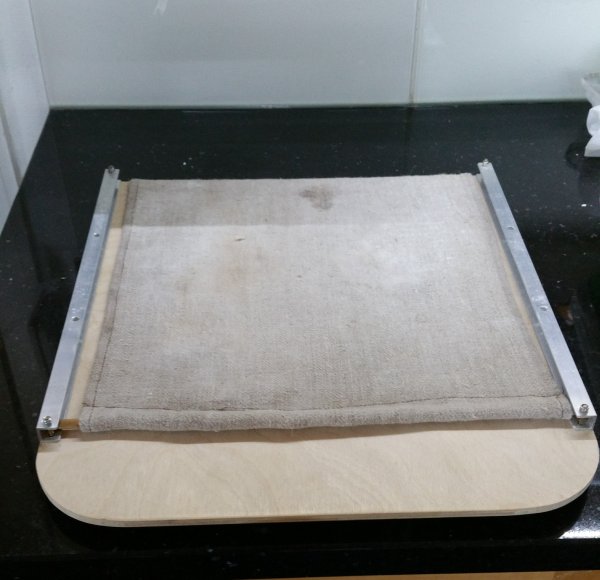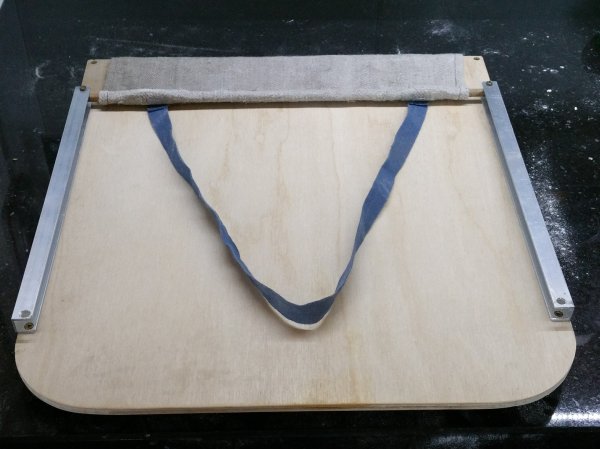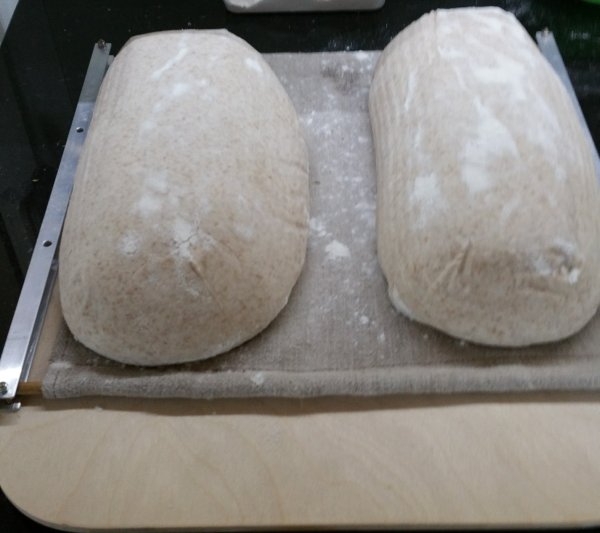Now I use a baking stone, I've had to work out a way of getting my loaves out of the bannetons and onto the stone.
For a while I used a pizza loading peel with a short handle. However I found this less than ideal; it can be quite rough on the dough, especially with higher hydrations and if there is any hint of overproofing. Also the dough can occasionally stick to the peel, despite use of rice flour, etc. And no good for loading more than one loaf.
So time for a bit of DIY design and build. As always, plenty of designs on the web to provide inspiration. I settled on a piece of 6mm birch ply with a rounded over bottom edge, 12mm aluminium U channel at the sides with 6mm dowels running in channels, attached to a piece of bakers linen.



I've been using this design for a few months now and am very pleased with the results.
Lance
I think you've just reinvented the Superpeel, more or less. Nice job!
Bran (storebought wheat or oat or better: sifted out of ww flour) is effective sprinkled on bannetoned dough bottoms, to prevent sticking to your linen or peel.
Tom
I like it! I can't quite visualize how it works though (assuming the piece of fabric doesn't go into the oven with the bread - where does it go?). It's great inventing your own tools. :)
Another thing to try, if you have trouble getting the dough to slide off the peel, is to put the dough on baking parchment on the peel, then slide the whole thing (dough on parchment) onto the stone. If you want you can slide the parchment out from under the loaves halfway through baking. Mostly I find that my peels release dough fairly well when they are rubbed with flour and then sprinkled with farina (cream of wheat).
LazyLoafer, I am not albacore, but it looks similar in concept to the superpeel. The first photo is the peel in the load position facing up, the second photo is the reverse side showing that nearly all the linen is on the top, except for a very small amount of linen and a fabric pull. The third photo shows the bread loaded onto the peel in the load position. The next step is to take the assembly to the oven, place the peel over the baking stone, and pull on the underside fabric pull, which will cause the linen to move to the underside, and let the bread "fall" onto the stone. I have a superpeel that I use for pizza, and it is beyond compare - I never ever have had anything stick to it.
That makes sense, and looks like a great idea!
Thanks Barryvabeach, your operational description is entirely accurate! I guess it is similar to the Superpeel, but I think many commercial oven loaders work on the same principle.
Compared to the Superpeel, I see my design as having the following advantages:
On the down side, I don't think my design would work well for pizza, unless the dough base was topped directly on the linen.
Lance
I load the baking (aka pizza) stones in my small oven by tipping the dough out onto silicone baking sheets, or baking parchment then peeling those onto the stone. I remove the silicone or parchment after the first 12-15 minutes. (magicians tablecloth trick sort of way) Before I did that, I simply slid the shelves out and went directly from bannetons into the stones, however my oven has been moved to a higher location now and that's not practical anymore.
I load the Rofco the same way - 4 large loaves onto a big square of silicone baking sheet the same size as the oven floors then use a big bit of plywood the same size to peel them into the oven shelves.
If only I were better at DIY...
Cheers,
-Gordon
Lance, you did a nice job on your construction. I have made a few knockoffs of the superpeel to fit particular ovens myself, though I like having a handle.
Nice job Lance!
I fooled around with a similar concept a few months ago but instead relied on direct contact between the cloth and the board. In fact the friction was too great and I couldn't get the cloth to slide freely. I like the concept of aluminum guides and I bet it helps a lot.
I'm guessing you load the board, line things up, then pull on the cloth handle below as you retract the assembly from the oven... yes?
Jim
Thanks for all your positive comments. I hope it's stimulated interest sufficient for people to get their DIY gear out!
Jim, I rounded over the bottom edge of the board with a router, using a rounding over bit, working from both sides. I'm sure you could do it with a palm sander or even by hand tho'. I think the trick is not to make the board too thin or the fabric wion't run smoothly from top to bottom. 6mm ply is fine.
In use I hold the peel with one hand, the tape ready tensioned with the other. Then put the peel into the oven sloping down at a slight angle. Touch the bottom of the peel onto the stone and start to pull it back as you pull the tape with the other hand.
It's more intuitive than it sounds!
Lance
Thanks Lance. I get it.
I was working with standard size baker's boards (26" X 18") which are already filleted on all edges. Even so I couldn't get the cloth to slide reliably. If you are not offended I may try a mock-up of your board.
Jim
Go for it Jim; I have no copyright on the design! I might christen it "The Smartpeel" tho'!
Lance
The inventor of the Super Peel (I use one and it's great) does have a patent on the invention. As long as you are DIY building one I think you are on safe grounds. However, one might be infringing on the patent if it is being manufactured for sale.
Hmmmm, now you've got me thinking some more. It seems a waste to proof the loaves on linen (either in a basket or a couche), and then move them to another piece of linen to load into the oven. I wonder if you could proof the loaves right on the device, maybe even overnight in the fridge? You'd have to have some kind of divider (maybe linen-covered rods) to put between the loaves to keep them from spreading into each other, as long as these dividers were easy to remove before loading. That would be a real time-saver if, say, you wanted to bake six loaves first thing in the morning, without getting up at the crack of dawn to shape and proof them. As I do... :)
Lazy L, I think to scale it up to hold six loaves at once (I think that's what you're suggesting?) would be pretty unwieldy, not to mention heavy when loaded with loaves.
I retard my loaves in the fridge overnight. I now use the green plastic bannetons (with liners). They say 500g, but they'll take 850g of sourdough. It only takes a moment to turn two of these out onto the peel, score them and pop them in the oven.
Lance
... but three. I bake on two decks, three loaves on each deck. If I had two of those whiz-bang loaders and could proof the loaves overnight on them, I could load a batch really quick!
Many thanks for this post! It really has me inspired to make my own.
I've already worked out a design with my brother (mechanical engineer) for a simplifed loader similar to the ones professional bakers use but is still DIY-able. So I'm hoping to build soon.
Great! Any enhancements to the Smartpeel are welome. Be sure to post your design here.
Lance
My go-to baguette recipe uses a very sticky, difficult to handle, dough. After trying various tools to move the shaped dough, I bought a 14" wide drywall taping knife. It's like a wide metal scraper and works like a charm for moving the proofed loaves onto a baguette pan. About $10 at Lowe's DIY. Link: http://www.goldblatttool.com/product_show.aspx?id=146
A couple of weeks ago, I suggested using a 14" wide drywall taping knife as peel. The one I purchased works well, but has one problem; it will rust if not washed and dried soon after use. However, the company makes an identical tool in stainless steel. That's what I'd buy if I were doing it again.
http://www.goldblatttool.com/product_show.aspx?id=145
here is a commercial version. not sure where it fits in the time line of superpeels development time-line. https://www.panimatic.com/OPTICOUCHE_821_76_1232.html
deren bakers couch also makes automatic couches. probably makes the above one. https://www.bakerscouche.com/
Thank you, Lance, very inspirational. I made one and tried it out today for the first time on a single 750-gram loaf and it worked a treat. My main reason to build one was when I load 3 baguettes at once without too much loss of steam and heat. Mine is heavily based on your version.
I wrote it up here: DIY dough loading peel | The Fresh Loaf.
Cheers,
Gavin.